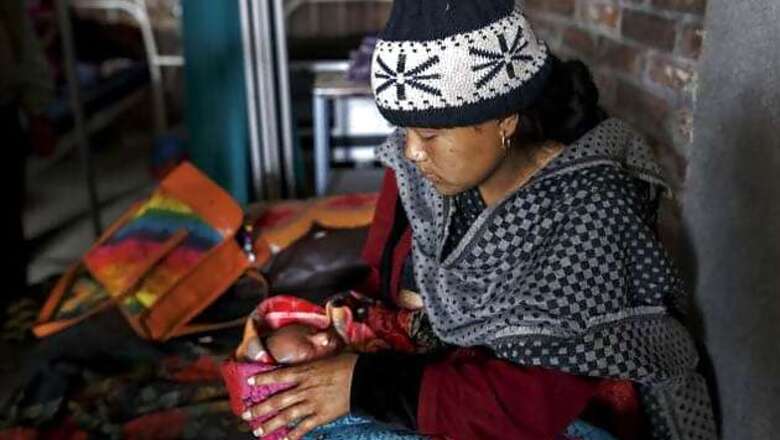
views
Jharibar: Her husband away in India, Sunthalia worked alone for hours in the rubble of her house perched on a ridge near the epicentre of Nepal's earthquake to pull out the bodies of her 10-year-old daughter and a son aged eight.
Another son of four miraculously survived.
Three other houses in their remote settlement, an hour's walk up the lush green Gorkha valley, had collapsed. It was deathly quiet after Saturday's quake, she recalls.
"I could see my son's fingers fluttering through the pile of stones. That's how I could see him and save him," Sunthalia said, sitting listlessly on the ground, her son by her side.
The stench of dead cattle still in the rubble of her home is overpowering. There is little government help so far; the only thing families such as hers have been given is a thin tarpaulin sheet to lie under.
Four days after the country's most powerful quake in 81 years, authorities are struggling to determine the extent of the disaster in the Gorkha region and neighbouring Lamjung where the epicentre lay, let alone provide succour.
The central government in Kathmandu still has little precise information on where the damage is most extensive and who needs help urgently. So far the official death toll has reached 4,349 in Nepal, but could more than double.
"The death toll could go up to 10,000 because information from remote villages hit by the earthquake is yet to come in," Prime Minister Sushil Koirala told Reuters in the capital.
MOUNTAINTOP DWELLINGS
Communities are so spread out in Gorkha that some mountaintop dwellings further north in the Barpak and Laprak areas can only be reached by walking three or four days.
The fear is that there are many more like Sunthalia who are alone in isolated settlements further away, burying their dead and living out in the open with little food, water, or access to urgent medical help.
On Tuesday, army soldiers were racing towards Barpak in two bus loads and then by foot up steep slopes to reach people feared trapped in their homes. A heavy downpour made their progress even more difficult.
Army helicopters tried twice to land in the Barpak area on Monday, but they could not find a suitable site, said Rishi Khatri, the Gorkha district health official who flew on one of the flights to help airlift the seriously injured.
They also circled over Laprak, where, according to local development records, there are 1,700 houses. Khatri estimates 1,600 were razed to the ground. They dropped food packets in the hope that survivors could gather them up.
"We couldn't see anyone from the air, no movement at all," said Khatri. "It is worrying; we think the number of casualties will rise many fold."
The only thing he could see on some mountaintops were the rotting carcasses of cattle.
The Gorkha region of snow-crested mountains and vast valleys is home to the builder of modern Nepal, King Prithvi Narayan Shah. He founded the Shah dynasty who ruled the Himalayan nation of 28 million people for 240 years until the abolition of the monarchy in 2008.
Gurkha soldiers in service in the Nepali, Indian and British armies also draw their name from the region.
Many men are away on deployment, leaving wives, children and the infirm at home.
"RUNNING, FALLING, RUNNING"
Santoshi, another survivor in Hulakdanda village, said she was thrown off a hillside by the earthquake as she sat eating her lunch outside while her two children played indoors.
She rushed back to find them hiding under the bed.
"Even then the tremors carried on. We were running, falling to the ground, and then running again."
A part of the hillside in Hulakdanda had caved in, releasing a torrent of rocks and mud into the stream below. Villagers said they had seen the gushing clear stream turn crimson, spouting mud and filth during the tremors.
"There is big damage on top of the mountains. The higher you go, the greater the destruction," said Tirthankar Thapa, who works for Kokila Nepal, a non-government organisation providing relief to people hit by the quake.
Thapa said survivors were forced to bury their dead even though that was not the custom among Hindu families.
Shyam Lal Shreshta, who lost his wife and mother-in-law in the disaster, waited for several hours to try and arrange a cremation. But as night fell he and his son took the bodies to the side of the stream and buried them there.
"There is nothing we have got from anyone. There is no government, no Red Cross, we don't even have a tent to sit in and mourn our loss," he said.


















Comments
0 comment